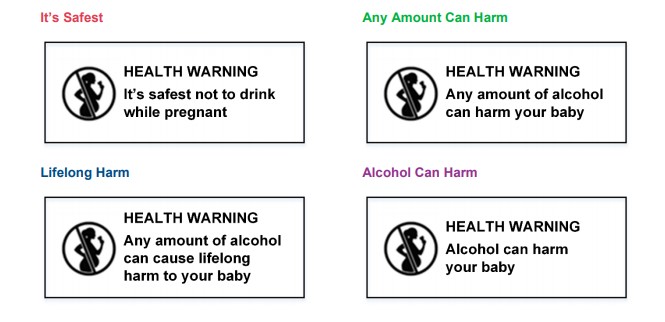
Indie brewers face $100m bill for pregnancy risk labels

The alcohol industry is pushing back over plans to make amended pregnancy risk warning labels on alcohol products mandatory, with the IBA saying the proposed scheme will cost indie brewers $100 million over the next 10 years.
While many brewers already voluntarily include a pregnancy risk label on the side of cans, the proposed new labels include a large written warning as well as an image.
The Food Standards agency says the changes aim to “raise awareness” and “prompt discussions about the risks of consuming alcohol during pregnancy”.
“The primary objective… is to provide a clear and easy to understand trigger to remind pregnant women, at both the point of sale and the potential point of consumption, to not drink alcohol,” it said.
A secondary objective was to “provide information to the community about the need for pregnant women to not drink alcohol”, according to a report from the agency.
Jamie Cook, chair of the Independent Brewers Association, said that the organisation would like to see a mandatory pregnancy warning labelling regime that “provides the right balance between achieving community outcomes and brewer member’s ability to responsibly sell, market and promote products”.
“We have asked all brewers to make representations to Federal and State Government to ensure a common-sense approach to the mandatory labelling is adopted,” he said.
“The current packaging proposals appear to be an over-reach and if imposed as a mandatory will lead to significant cost increases.
“The IBA has estimated that the one-off and on-going costs of labelling as per the proposed changes could cost the independent brewers up to $100 million over the next 10 years.”
Update: A previous version of this article stated a $10 million, in actual fact this number is $100 million.
Alcohol Beverages Australia (ABA), which is making submissions on behalf of the industry, urged brewers to get on board and voice their opinions.
“The important points we are trying to make are that we do have an existing initiative. The industry, through DrinkWise, developed labels and funded a multifaceted campaign across a number of communication channels.
“It’s one that provides flexibility across container size, does not impose significant costs, and there is a fair chunk of industry involved already,” Andrew Wilsmore, chief executive of the ABA, told Brews News.
“By contrast the label proposed is significantly larger than previous versions and it takes away from more important content like allergen advice and alcohol content.”

Examples of messaging suggested by Food Standards.
He said there were a number of issues with the proposed label in addition to this, including the additional colour which would add to printing costs, as well as the costs of changing packaging an adding labels which would cause additional strain on supply chains or be transferred to the customer.
The industry is also questioning whether enforcing a mandatory label would actually change any social issues that lead to drinking alcohol while pregnant, he said.
“The report from Food Standards acknowledges that labelling won’t change at-risk consumers. The most at risk are unlikely to respond to a warning label, although it can help lead to improvements in awareness.”
Wilsmore said that the DrinkWise voluntary label initiative, as well as other factors like point-of-sale warnings and awareness campaigns,had already seen an improvement in awareness.
According to the most recent published National Drug Strategy Household Survey, a total of 98.8 per cent women reported they either abstained or consumed less alcohol in 2016 compared to 96.6 per cent in 2004.
Fifty-six per cent said they did not drink alcohol at all, in keeping with Australian governmental health advice, even though it is “not yet known how much alcohol is safe to drink during pregnancy,” according to the Australian Institute of Health and Welfare.
“We’ve already got high levels of awareness,” said Wilsmore.“Our issue is whether all of this is really necessary when we already have a voluntary initiative, which aims for similar if not the same outcomes.”
The concept of a mandatory warning has been in the works since 2011 and it was even suggested in the 1990s.
In 2011, the Australia and New Zealand Ministerial Forum on Food Regulation advised a two-year period in which companies could voluntarily place pregnancy warnings on packaging before any legislative changes were made. In 2014, another two year period was advised, and this was extended again in 2017.
In October 2018, ministers agreed to ask FSANZ to consider mandatory pregnancy warning labelling on packaged alcoholic beverages “as a priority and that the work be completed expeditiously”.
There is no indication of why this was expedited after nearly seven years of extensions to the voluntary risk warning scheme.
The agency advised that labels should have a pictogram as well as a warning statement, should include a short warning message, contrasting colours and be separated from other information on the can.
If the labels were made mandatory, imported alcohol products would need to include supplementary label, which would be allowed under the scheme.
Brett Heffernan, CEO of the Brewers Association Australia which represents Lion, CUB an Coopers, last year said the mandatory labeling system was a “no brainer”.
“We are perplexed as to why others in the industry failed to heed the writing on the wall since 2012. The three major brewers got the job done, across hundreds of product labels, in just two years,” he said at the time.
When contacted by Brews News in relation to the latest proposals, Heffernan said there was not much value in adding anything at this stage.
The Food Standards agency is calling for further submissions on the proposals.



